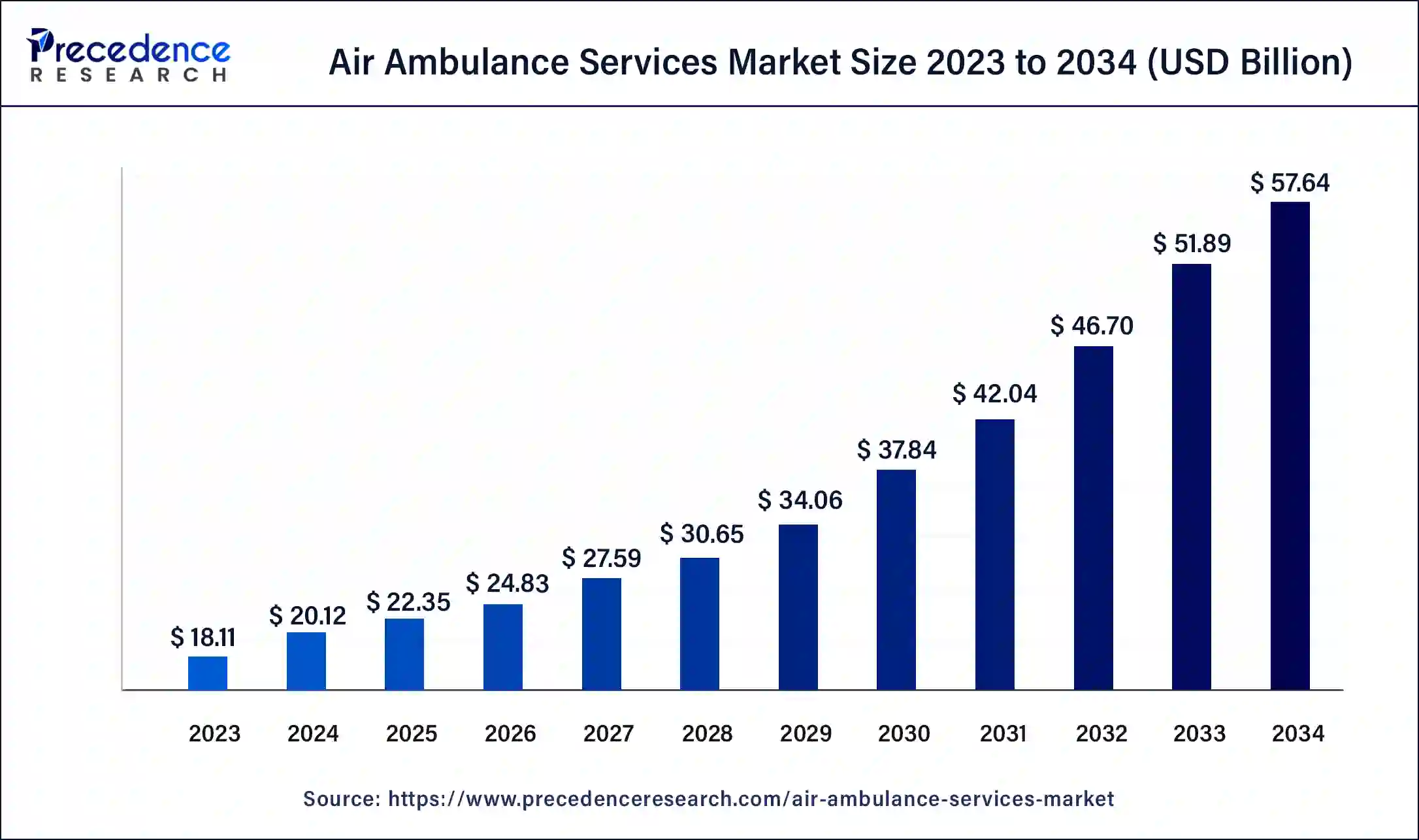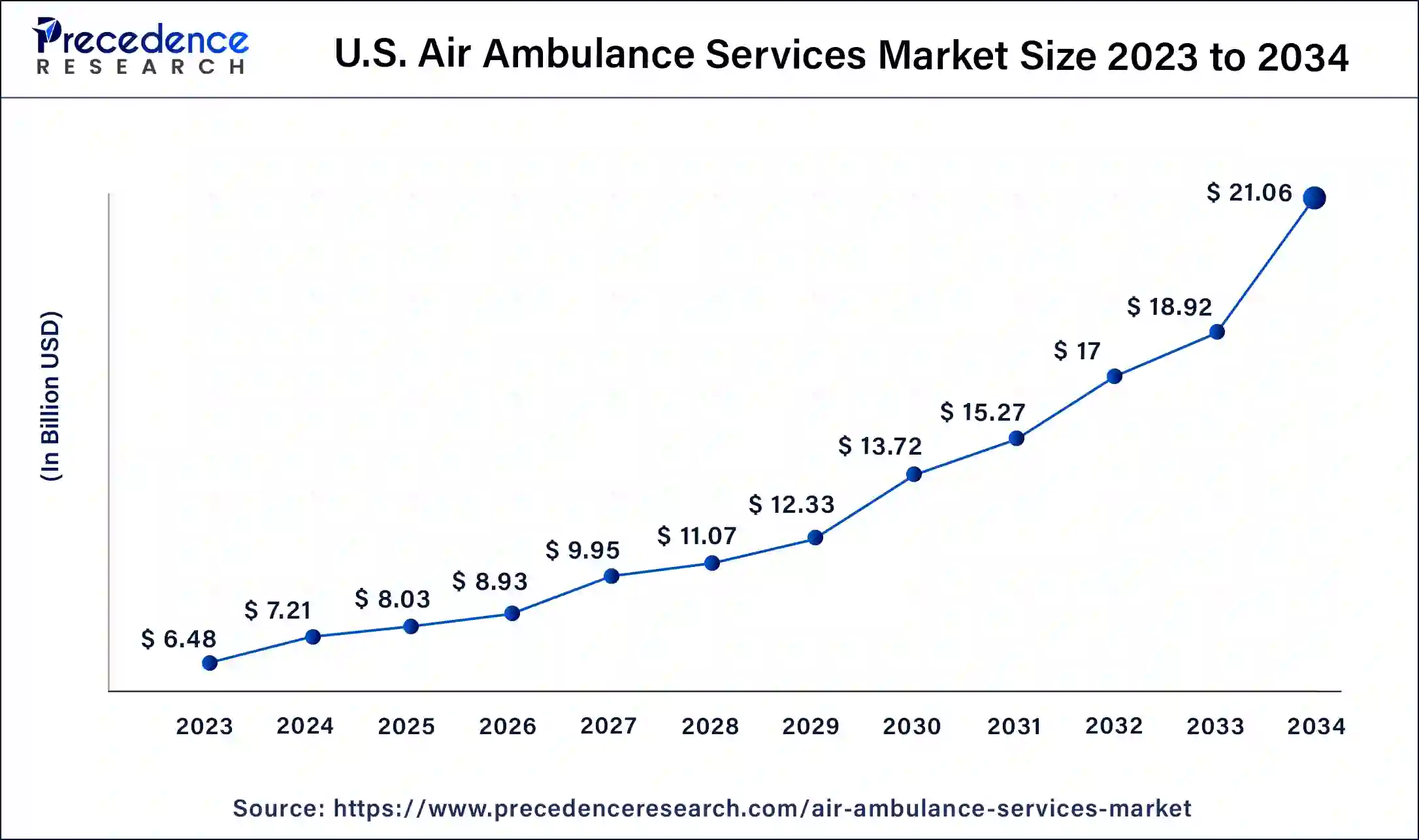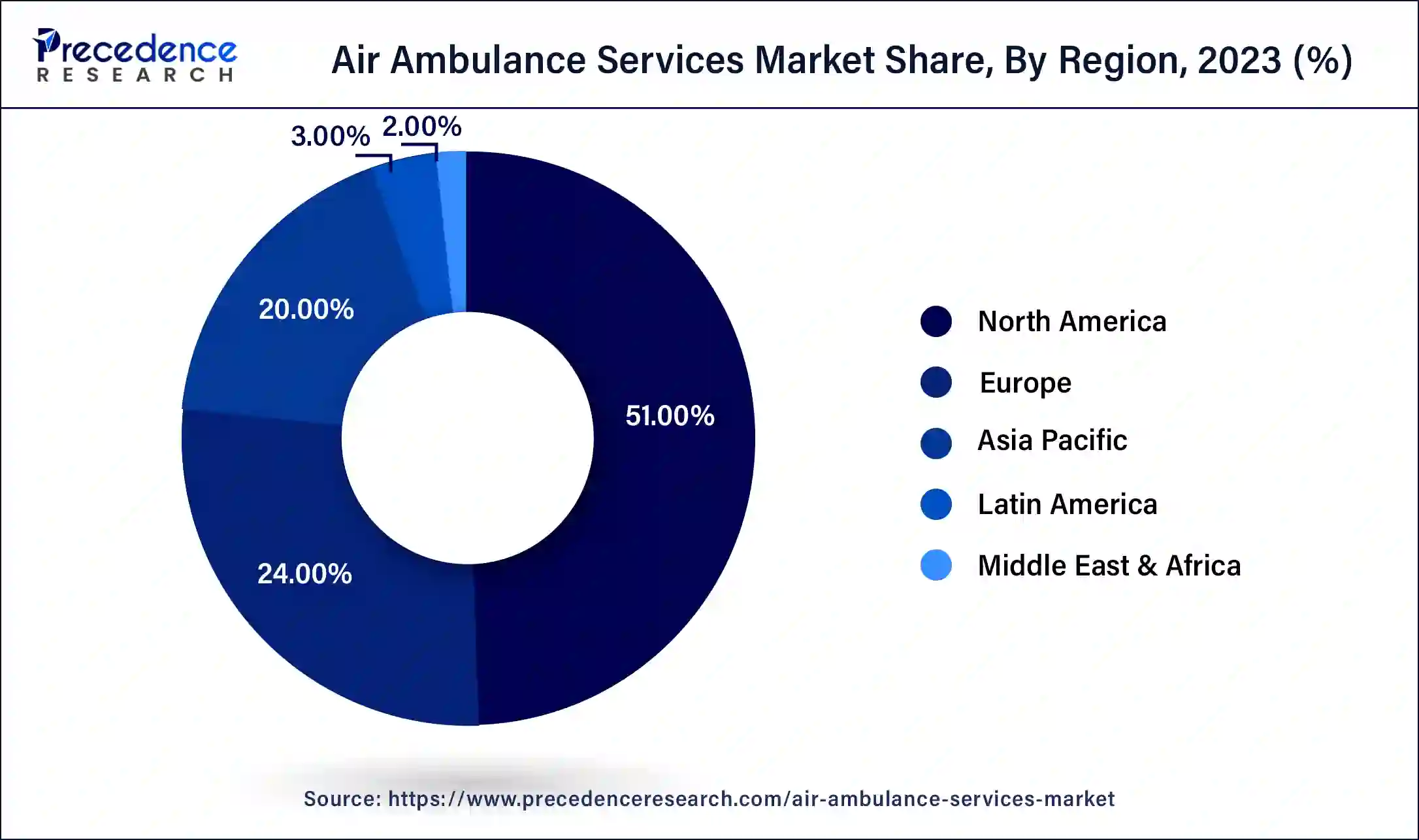Air Ambulance Services Market Size and Forecast 2025 to 2034
The global air ambulance services market size accounted for USD 20.12 billion in 2024, and is anticipated to hit around USD 22.35 billion by 2025, and is expected to be worth around USD 57.64 billion by 2034, at a CAGR of 11.1% from 2025 to 2034. The North America air ambulance services market size reached USD 9.24 billion in 2023.

Air Ambulance Services Market Key Takeaways
- In terms of revenue, the market is valued at $1 billion in 2025.
- It is projected to reach $57.64 billion by 2034.
- The market is expected to grow at a CAGR of 11.10% from 2025 to 2034.
- North America dominated the market with the largest market share of 51% in 2024.
- Asia Pacific region is expected to expand at the fastest CAGR from 2025 to 2034.
- By Aircraft Type, the fixed wings segment is expected to witness the fastest rate of growth throughout the forecast period.
- By Service Operator, the hospital-based segment led the global market in 2024.
U.S. Air Ambulance Services Market Size and Growth 2025 to 2034
The U.S. air ambulance services market size was estimated at USD 7.21 billion in 2024 and is predicted to be worth around USD 21.06 billion by 2034, at a CAGR of 11.3% from 2025 to 2034.

North America held a considerable revenue share in 2024. The US dominated the North America region in 2024. The growth of the air ambulance services market within the region is being fueled by the increasing frequency of medical emergencies as well as the increasing aging population. Furthermore, the region enjoys a distinct advantage stemming from the availability of progressive medical facilities, and this coupled with the adoption of cutting-edge, technologically advanced air ambulance services, serves as a significant factor in the growth of the regional market revenue.
Furthermore, the United States healthcare system's emphasis on quality healthcare delivery is another factor driving the growth of air ambulance services. Hospitals and medical facilities prioritize efficient patient transfer to ensure that individuals receive appropriate treatments without delay. This is also likely to support the regional growth of the market.
Asia-Pacific is expected to grow at the fastest CAGR during the forecast period.Emerging economies in the countries with the potential of adopting technologies such as China, India and Japan have shown a significant swift. The market in the region is observed to grow with the government's substantial efforts on improving healthcare services. Moreover, the healthcare sector in Asia Pacific is focused on advancing services with more advanced and real-time communication systems for quality care. This factor is observed to promote the market's growth. The presence of potential manufacturers to develop advanced modes of transportation in the region is expected to fuel the market's growth.

Market Overview
Air ambulances serve as a lifeline for very ill patients, playing an indispensable role in providing swift and vital emergency services, especially during severe situations. Chief responders rely on these services to conveniently transport patients from the scenes of injuries or accidents to nearby hospitals, saving precious minutes that can make all the difference. Moreover, air ambulances are a critical resource for physicians who need to transfer patients between healthcare facilities to access specialized care, such as trauma, cardiac, or stroke treatment that may not be available at the initial location.
In recent years, the air ambulance market, particularly air ambulance helicopters, has undergone remarkable transformations. The median prices charged by air ambulance providers for helicopter transport have experienced a substantial increase, nearly doubling in many cases. This upward trend in prices has been coupled with a significant rise in the number of air ambulance helicopters in operation. These developments have reshaped the landscape of emergency medical transportation, paving the way for more efficient and advanced services.
Various factors have contributed to the changes in air ambulance prices. Transport costs, including fuel, maintenance, and operational expenses, have had a direct impact on the pricing structure. Additionally, the volume of transport has played a role in shaping prices, as demand fluctuates based on geographic location, population density, and the prevalence of medical emergencies. It is evident that these factors will continue to influence the pricing dynamics of air ambulance services in the foreseeable future.
Air Ambulance Services Market Growth Factors
The utilization of air ambulances for patient transportation is on the rise, driven by advancements in technology within the air ambulance services sector. These technological developments consist of innovative equipment like advanced ventilator systems and heart monitoring devices, significantly enhancing the likelihood of patients' survival during their transit to the nearest medical facility.
Furthermore, advanced communication systems allow the real-time transfer of patient data to hospitals, enabling doctors to receive crucial information promptly and make informed decisions to save lives. Furthermore, the growing number of accidents and various medical emergencies, including heart attacks and strokes, has also led to a surge in demand for air ambulance services. Additionally, the market's expansion is further accelerated by the increasing collaborations between government bodies and helicopter emergency medical services (HEMS) providers.
As the air ambulance industry continues to evolve, providers are continuously striving to enhance their services and expand their reach. Ensuring the safety and efficiency of air ambulance operations remains paramount, requiring ongoing investments in innovative aviation technology and medical equipment. Furthermore, skilled medical personnel, including flight nurses, paramedics, and experienced pilots, are indispensable for the successful execution of these critical missions. As advancements in medical technology and aviation continue to improve the capabilities of air ambulances, these services will undoubtedly remain at the forefront of emergency medical response, providing vital support to patients and medical professionals alike.
- Growing Emergency Medical Needs: The increasing number of acute emergencies or accidents occurring around the world is driving demand for immediate medical evacuation and transport, which air ambulance services provide on an increasingly urgent and effective basis.
- Development of Medical Technology: The systematic improvements in medical devices and equipment, alongside the integration of telemedicine and other telehealth technology onboard, are being integrated to provide better care and treatment for patients as they are being medically airlifted. This is beneficial to the market growth of air ambulance services.
- Growth in Chronic illnesses and Trauma Cases: The increase in chronic diseases, along with people becoming increasingly rely on medical support for trauma cases, is also forcing people to use air ambulance services for timely interventions.
- Government Initiatives and Support: Support from governments for emergency healthcare infrastructure and subsidizing air ambulance services, as well as the increase in growth and acceptance of air ambulance services in urban and needy areas.
Market Scope
| Report Coverage | Details |
| Market Size by 2034 | USD 57.64 Billion |
| Market Size in 2025 | USD 22.35 Billion |
| Market Size in 2024 | USD 20.12 Billion |
| Growth Rate from 2025 to 2034 | CAGR of 11.1% |
| Largest Market | North America |
| Base Year | 2024 |
| Forecast Period | 2025 to 2034 |
| Segments Covered | Aircraft Type, Service Operator, and Region |
| Regions Covered | North America, Europe, Asia-Pacific, Latin America, and Middle East & Africa |
Market Dynamics
Drivers
Rising aging population and prevalence of chronic diseases
The growing aging population and prevalence of chronic disorders is expected to fuel the growth of the air ambulance services market during the forecast period. The world's population is experiencing a significant demographic shift, with a considerable increase in the number of elderly individuals. An aging population is more susceptible to various health issues, such as heart diseases, respiratory problems as well as mobility impairments and often requires more frequent medical attention and is at a higher risk of experiencing medical emergencies. In such cases, air ambulance services are used for transporting elderly patients to medical centers that are equipped to handle their specific healthcare needs.
Furthermore, chronic diseases, such as diabetes, cardiovascular diseases, cancer, and respiratory conditions, are becoming increasingly prevalent worldwide. These diseases need medical management and can lead to acute or life-threatening emergencies. Such patients are likely to experience sudden complications or deteriorations in their health, necessitating immediate medical attention and transfer to specialized healthcare facilities. Air ambulance services make sure the timely transportation of such patients, especially when ground transportation may not be possible due to long distances or time constraints. Thus, the prevalence of chronic diseases is expected to fuel the demand for air ambulance services within the estimated timeframe.
Restraint
High costs of air ambulance
The high costs are likely to limit the growth of the air ambulance services market during the forecast period. The cost of an air ambulance flight within the United States typically varies between $12,000 and $55,000. Numerous elements influence the pricing of air ambulance services. The distance to be covered is significant in determining the overall cost. Longer distances entail higher fuel consumption, increased crew hours, and additional operational resources, all of which contribute to escalated expenses. Moreover, operational costs, encompassing maintenance, insurance, licensing, and adherence to aviation regulations, also impact the total expenditure of air ambulance services.
Opportunity
The emergence of AI
The emergence of artificial intelligence is likely to offer growth opportunities for the air ambulance services market in the years to come. The plane will operate autonomously, driven by an artificial intelligence (AI) system overseen by a skilled pilot from a remote command center. The AI technology integrated within the aircraft will navigate it adeptly through challenging urban settings. Upon reaching the site of the incident, a paramedic will provide immediate stabilization for the patient. Subsequently, the patient can be transported to a hospital significantly faster than if traditional land-based emergency response vehicles were employed.
Furthermore, artificial intelligence (AI) holds the promise of enhancing urban air mobility, elevating airline safety measures, streamlining flight scheduling processes, and facilitating predictive maintenance for aircraft. Through sophisticated algorithms, AI can comprehensively analyze diverse flight data, encompassing variables such as route length, altitudes, mileage, fuel consumption, and weather conditions, among others. By leveraging AI's capabilities, the application calculates the most efficient flight trajectory, not only minimizing emergency flight duration but also optimizing fuel consumption throughout the journey.
Aircraft Type Insights
The fixed-wing segment is expected to grow at the fastest rate during the forecast period. Fixed-wing air ambulances excel in covering extensive distances due to their superior fuel capacity in comparison to rotary-wing aircraft. Aircraft employing propellers are predominantly utilized for shorter journeys. Some of these propeller-driven planes, commonly referred to as turboprops, are occasionally employed for extended or remote travel.
Additionally, fixed-wing aircraft possess the capability to navigate challenging weather conditions at higher speeds and with extended range, all while ensuring the comfort of patients. Fixed-wing aircraft often carry the capacity to operate even during adverse environments, this element promotes the segment's growth.
Service Operator Insights
The hospital-based segment dominated the global air ambulance services market in 2024, the segment is observed to sustain its dominance throughout the forecast period. Hospital-based air ambulance services cater to the urgent medical needs of individuals residing in remote or outlying areas, distanced from urban centers. These air ambulances are staffed by a proficient medical team proficient in adhering to essential pre-hospital care protocols, ensuring efficient responses to emergencies and the needs of critically ill patients.
The helicopters employed by these services are exclusively designed to facilitate the swift transportation of individuals in urgent situations. Also, the medical personnel engaged in these transfers are sourced directly from hospitals. A skilled cohort of emergency physicians and paramedics, meticulously trained for airborne evacuations, is consistently present on all air-transfers. These services extend support to a diverse range of accident and emergency cases, encompassing even pediatric patients. These factors are likely to support the growth of the segment within the estimated timeframe.
Air Ambulance Services Market Companies
- Air Methods Corporation
- PHI Air Medical
- REVA, Inc.
- Global Medical Response (GMR)
- Acadian Air Med
- AMR Air Ambulance (American Medical Response)
- Babcock Scandinavian Air Ambulance
- AirMed International
- Air Ambulance Worldwide
- Jet Rescue Air Ambulance
- AeroCare Medical Transport System
- Lifeguard Air Ambulance
Recent Developments
- In February 2025, the Indian government signed a USD 1 billion deal with an IIT startup in India to launch eVTOL Air Ambulance Services, facilitating medical emergencies. The eVTOL air ambulances will have a top speed of 200 kmph and a flight range between 110 km and 200 km per charge, making them ideal for quick-response emergency services in both urban and remote locations. (Source: https://www.timesnownews.com)
- In April 2025, Global Medical Response (GMR) launched the Airbus H140 medical helicopter, a purpose-built aircraft designed from the ground up to meet the complex needs of the air medical transport industry. In North America. “Our involvement with Airbus from the earliest phases has been about ensuring every detail of this aircraft is aligned with the real-world demands of air medical operations,” said GMR Chief Operating Officer Ted Van Horne. (Source: https://www.airmedandrescue.com)
- In October 2024, Prime Minister Narendra Modi virtually inaugurated the country's first free helicopter emergency medical service (HEMS) at AIIMS Rishikesh. This innovative service is part of a larger initiative to enhance healthcare infrastructure across the country, with multiple projects worth over Rs 12,850 crore. (Source: https://www.newindianexpress.com)
- In August 2023, RED Health introduced its air ambulance service, currently accessible in Hyderabad and more than 550 other cities across India. These air ambulances offer cutting-edge medical technology and are staffed by extensively qualified critical care experts. The fleet comprises eight specialized aircraft, strategically capable of swiftly and effectively evacuating patients from diverse terrains and regions within the nation.
Segments Covered in the Report
By Aircraft Type
- Fixed-Wing
- Rotary-Wing
By Service Operator
- Hospital-based
- Independent
- Government
By Region
- North America
- Europe
- Asia-Pacific
- Latin America
- Middle East and Africa
For inquiries regarding discounts, bulk purchases, or customization requests, please contact us at sales@precedenceresearch.com
Frequently Asked Questions
Ask For Sample
No cookie-cutter, only authentic analysis – take the 1st step to become a Precedence Research client
 sales@precedenceresearch.com
sales@precedenceresearch.com
 +1 804-441-9344
+1 804-441-9344